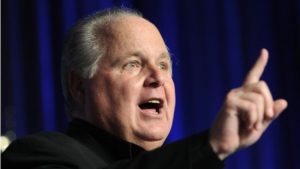

This point is obvious once you think about it. It’s basic economics. It’s just that I had never thought about it.
It is also worth noting that talk radio in the 1980s was a much more ideologically diverse industry than it is today, with many hosts from both the political left and right. Contrary to conservative talk radio hosts who explain their dominance by the existence of a silent majority of average Joe listeners, ironically it was the federal government that boosted right-wing dominance of talk radio.
As historian Brian Rosenwald argues, left-wing talk radio hosts had to compete for listeners with government-subsidized, center-left NPR affiliates, while right-wing hosts had a clearer competitive field. Station owners could guarantee a larger audience to advertisers simply by picking right-wing instead of left-wing talk radio programs. Talk radio’s conservative bent is the unintended product of the government’s halfhearted attempt to create a nationalized broadcasting system in the 1970s. (Though I wouldn’t expect a “Rush was Made Possible By Listeners like You” slogan to appear on a complimentary NPR tote bag any time soon.)
From Paul Matzko, “The Fairness Doctrine Was the Most Deserving Target of Rush Limbaugh’s Rage,” Reason.com, February 19, 2021.

READER COMMENTS
Andrew_FL
Feb 20 2021 at 2:31am
Doubtless this is true as far as it goes, but how far does it really go? If there were simply comparable market demand for left and right wing radio, but little left wing broadcasters were simply unable to compete with big bad NPR, I would expect NPR to have comparable listenership to all of right wing talk radio combined. That’s obviously not true.
Demographics is probably more important. The age and income ranges of people who are likely to tune into the radio daily simply skews well to the right of consumers of most other forms of media.
BC
Feb 20 2021 at 4:44am
Maybe, NPR is good enough to take enough market share from private liberal radio so as to make private liberal radio unviable but not good enough to attract a large audience itself.
Think of government schools. With the taxpayer subsidies, they are good enough to squeeze out a lot of private non-religious schools. Government schools don’t provide religious education, so there is still a market for private religious schools. But, because government schools have to deal with public school teachers unions, they have more difficulty than private schools providing in-person instruction now. So, in-person learning is probably dominated by, or at least disproportionately, religious education. The taxpayer subsidies allow government schools to squeeze out private, non-union, non-religious schools but not private, non-union, religious schools.
Matthias
Feb 20 2021 at 10:07pm
There might also be an analogy with established religions in Europe.
In eg the UK the head of state and head of Anglican church are the same person and the church has guaranteed seats in the legislative. In Germany churches can ask the government to collect tithes on their behalf through the tax system. Etc.
In America there’s more of a religious free for all.
Garrett
Feb 21 2021 at 10:47pm
Sounds like a crowding out effect
Comments are closed.